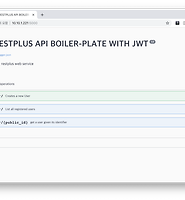| 일 | 월 | 화 | 수 | 목 | 금 | 토 |
|---|---|---|---|---|---|---|
| 1 | 2 | 3 | 4 | 5 | ||
| 6 | 7 | 8 | 9 | 10 | 11 | 12 |
| 13 | 14 | 15 | 16 | 17 | 18 | 19 |
| 20 | 21 | 22 | 23 | 24 | 25 | 26 |
| 27 | 28 | 29 | 30 |
- appium
- SWIFT
- mysql
- postgres
- nGrinder
- STF
- perfect
- ubuntu
- 28015
- rethinkdb
- STF_PortForwarding
- nmap
- ftp
- 실행권한
- sshpass
- port forwarding
- Jupyter
- appium server
- create table
- ssh
- nohup
- kitura
- postgresql
- insert
- Jupyter Notebook
- openpyxl
- GoCD
- PYTHON
- centos
- Materials
- Today
- Total
don't stop believing
Flask로 API 서버 만들기 (2) - config 와 실행 확인 본문
Developing API Sample Server by Flask
Original Post: How to structure a Flask-RESTPlus web service for production builds
Github: https://github.com/cosmic-byte/flask-restplus-boilerplate
Flask로 API 서버 만들기 (1) - 개발 환경 준비
Flask로 API 서버 만들기 (2) - config 와 실행 확인
Flask로 API 서버 만들기 (3) - User 테이블 만들기
Flask로 API 서버 만들기 (4) - Testing
Flask로 API 서버 만들기 (5) - User Operations
Flask로 API 서버 만들기 (6) - Security and Authentication
Flask를 이용한 개발환경 준비를 완료했다면 이제 개발을 시작해 봅시다.
main directory 안에 config.py를 만들고 API 서버의 설정 정보들을 구성하는 코드를 작성합니다.
1$ sudo vim ./app/main/config.py
config.py 파일안에 아래와 같이 작성합니다.
123456789101112131415161718192021222324252627282930313233343536373839404142import os# uncomment the line below for postgres database url from environment variable# postgres_local_base = os.environ['DATABASE_URL']basedir = os.path.abspath(os.path.dirname(__file__))class Config:SECRET_KEY = os.getenv('SECRET_KEY', 'ngle_api_tongchun')DEBUG = Falseclass DevelopmentConfig(Config):# uncomment the line below to use postgres# SQLALCHEMY_DATABASE_URI = postgres_local_baseDEBUG = TrueSQLALCHEMY_DATABASE_URI = 'sqlite:///' + os.path.join(basedir, 'flask_boilerplate_main.db')SQLALCHEMY_TRACK_MODIFICATIONS = Falseclass TestingConfig(Config):DEBUG = TrueTESTING = TrueSQLALCHEMY_DATABASE_URI = 'sqlite:///' + os.path.join(basedir, 'flask_boilerplate_test.db')PRESERVE_CONTEXT_ON_EXCEPTION = FalseSQLALCHEMY_TRACK_MODIFICATIONS = Falseclass ProductionConfig(Config):DEBUG = False# uncomment the line below to use postgres# SQLALCHEMY_DATABASE_URI = postgres_local_baseconfig_by_name = dict(dev=DevelopmentConfig,test=TestingConfig,prod=ProductionConfig)key = Config.SECRET_KEY
config.py 파일에는 API 서버의 3가지 환경을 설정할 수 있는 class 가 있습니다.
DevelopmentConfig, TestingConfig, ProductionConfig
main 폴더아래 있는 __init__.py 파일에 아래와 같이 작성합니다.
1$ sudo vim ./app/main/__init__.py
아래 script는 config 정보를 받아 flask object를 생성하게 됩니다.
1234567891011121314151617from flask import Flaskfrom flask_sqlalchemy import SQLAlchemyfrom flask_bcrypt import Bcryptfrom .config import config_by_namedb = SQLAlchemy()flask_bcrypt = Bcrypt()def create_app(config_name):app = Flask(__name__)app.config.from_object(config_by_name[config_name])db.init_app(app)flask_bcrypt.init_app(app)return app
이제 API 서버의 entry point를 만들 차례입니다.
1$ sudo vim manage.py
manage.py 파알안에 아래 script를 추가합니다.
123456789101112131415161718192021222324252627282930313233import osimport unittestfrom flask_migrate import Migrate, MigrateCommandfrom flask_script import Managerfrom app.main import create_app, dbapp = create_app(os.getenv('BOILERPLATE_ENV') or 'dev')app.app_context().push()manager = Manager(app)migrate = Migrate(app, db)manager.add_command('db', MigrateCommand)@manager.commanddef run():app.run()@manager.commanddef test():"""Runs the unit tests."""tests = unittest.TestLoader().discover('app/test', pattern='test*.py')result = unittest.TextTestRunner(verbosity=2).run(tests)if result.wasSuccessful():return 0return 1if __name__ == '__main__':manager.run()
이제 저장하고 실행해 보겠습니다.
1$ python manage.py run
만약 실행했을때 아래와 같은 warning이 보인다면 FLASK_ENV를 추가해 줘야 합니다.
1$ export FLASK_ENV=development
이제 다시 python manage.py run을 실행합니다.
flask 실행까지 확인했으니 다음 post로 넘어가겠습니다.
'Python > Flask' 카테고리의 다른 글
| Flask로 API 서버 만들기 (6) - Security and Authentication (0) | 2018.11.12 |
|---|---|
| Flask로 API 서버 만들기 (5) - User Operations (2) | 2018.11.12 |
| Flask로 API 서버 만들기 (4) - Testing (0) | 2018.11.12 |
| Flask로 API 서버 만들기 (3) - User 테이블 만들기 (2) | 2018.11.12 |
| Flask로 API 서버 만들기 (1) - 개발 환경 준비 (1) | 2018.11.06 |



